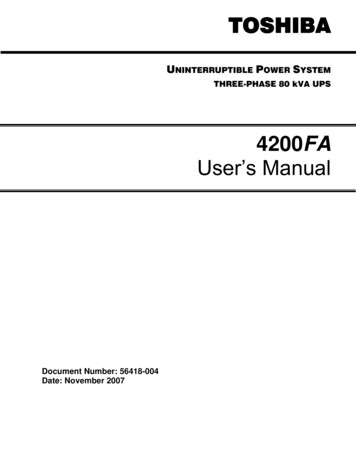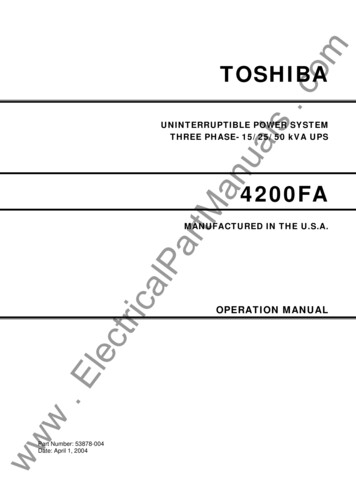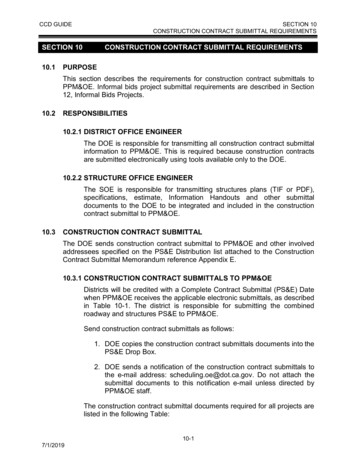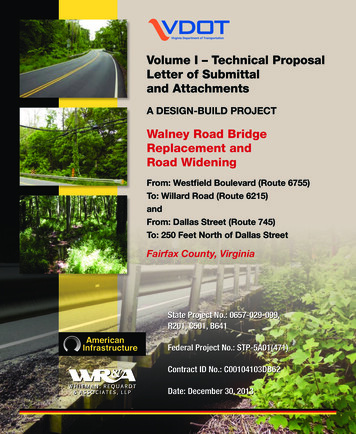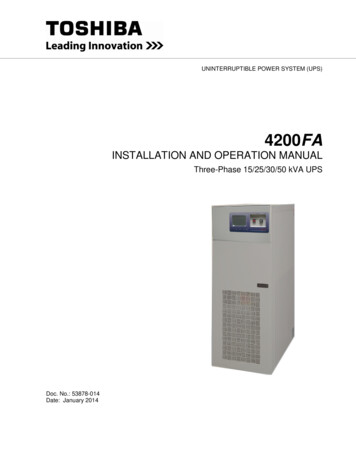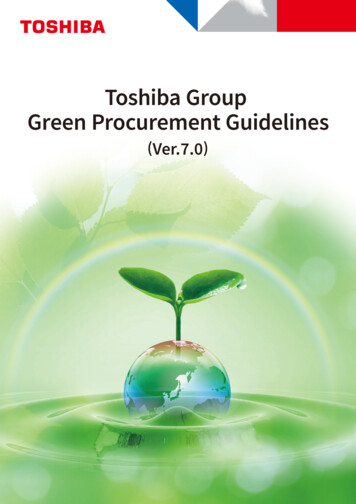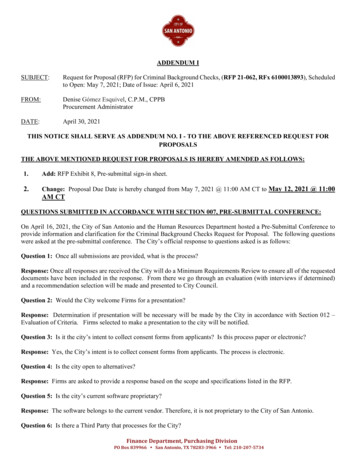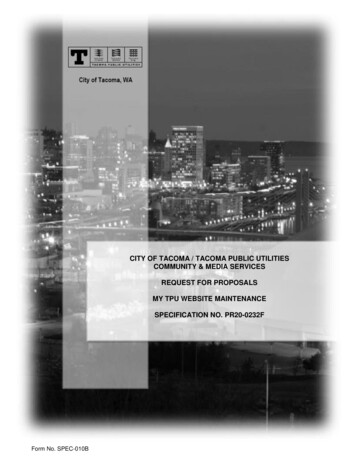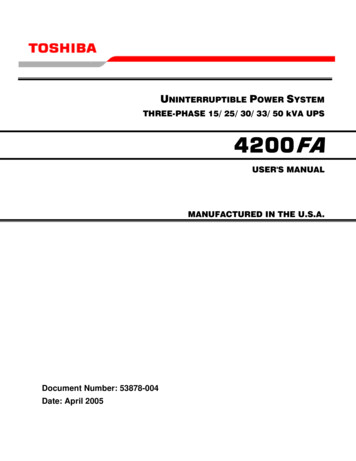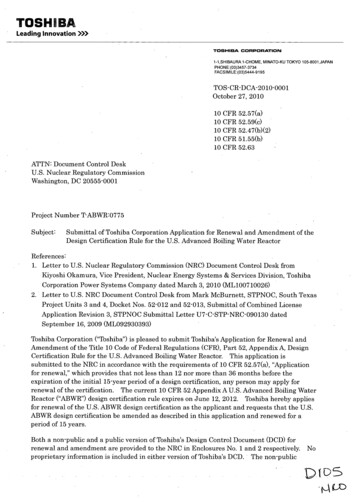
Transcription
TOSHIBALeading Innovation TOSHIBA CORPORATION1-1,SHIBAURA 1-CHOME, MINATO-KU TOKYO 4-9195TOS-CR-DCA-2010-0001October 27, (b)(2)51.55(b)52.63ATTN: Document Control DeskU.S. Nuclear Regulatory CommissionWashington, DC 20555-0001Project Number T-ABWR:0775Subject:Submittal of Toshiba Corporation, Application for Renewal and Amendment of theDesign Certification Rule for the U.S. Advanced Boiling Water ReactorReferences:1. Letter to U.S. Nuclear Regulatory Commission (NRC) Document Control Desk fromKiyoshi Okamura, Vice President, Nuclear Energy Systems & Services Division, ToshibaCorporation Power Systems Company dated March 3, 2010 (ML100710026)2. Letter to U.S. NRC Document Control Desk from Mark McBurnett, STPNOC, South TexasProject Units 3 and 4, Docket Nos. 52-012 and 52-013, Submittal of Combined LicenseApplication Revision 3, STPNOC Submittal Letter U7-C-STP-NRC-090130 datedSeptember 16, 2009 (ML092930393)Toshiba Corporation ("Toshiba") is pleased to submit Toshiba's Application for Renewal andAmendment of the Title 10 Code of Federal Regulations (CFR), Part 52, Appendix A, DesignCertification Rule for the U.S. Advanced Boiling Water Reactor. This application issubmitted to the NRC in accordance with the requirements of 10 CFR 52.57(a), "Applicationfor renewal," which provides that not less than 12 nor more than 36 months before theexpiration of the initial 15-year period of a design certification, any person may apply forrenewal of the certification. The current 10 CFR 52 Appendix A U.S. Advanced Boiling WaterReactor ("ABWR") design certification rule expires on June 12, 2012. Toshiba hereby appliesfor renewal of the U.S. ABWR design certification as the applicant and requests that the U.S.ABWR design certification be amended as described in this application and renewed for aperiod of 15 years.Both a non-public and a public version of Toshiba's Design Control Document (DCD) forrenewal and amendment are provided to the NRC in Enclosures No. 1 and 2 respectively.proprietary information is included in either version of Toshiba's DCD. The non-publicNo
TOSHIBALeading Innovation version of the DCD contains security-related sensitive information that should be withheldfrom public disclosure under 10 CFR 2.390. No security-related information is provided inthis transmittal letter itself.Toshiba previously informedthe NRC of its intent to submit this application by letter datedMarch 3, 2010 (Reference 1). In addition, on August 24, 2010, Toshiba representatives metwith members of the NRC staff in a pre-application meeting and presented Toshiba's plans forrequesting renewal and amendment of the design certification.In addition to the renewal, Toshiba requests that the U.S. ABWR design certification beamended pursuant to 10 CFR 52.59(c) to address the following:* Incorporation of features to address the requirements of 10 CFR 50.150, "Aircraft**impact assessment,"Incorporation of specified design departures in order to make the ABWR designcertification rule similar to the South Texas Project Units 3 and 4 Combined LicenseApplication Revision 3 (Reference 2), andIncorporation of a revised fuel design.The proposed amendments to the U.S. ABWR design certification satisfy the criteria contained in10 CFR 52.63 pertaining to the finality of designs. Specifically, the proposed amendments willmake the ABWR design similar to the South Texas Project Units 3 and 4 COLA Revision 3, andinclude the AIA amendment proposed by STPNOC. Accordingly, the amendments meet thecriteria set forth in 10 CFR 52.63(a)(1)(vii) because they contribute to increased standardization ofthe certification information.A Change List is provided as Attachment No. 1 to this application. Pages of the proposed renewaland amended DCD are marked with revision bars to identify changes. Pages are also markedwith Toshiba document number "RS'5146900 Rev. 0."A Commitment List is provided as Attachment No. 2 to this application. This Commitment Listprovides Toshiba commitment dates for making available DCD-referenced documents that are notcurrently available to the NRC.In addition, 10 CFR 52.47(b)(2) and 10 CFR 51.55(b) require each applicant for an amendment to adesign certification to submit with its application a separate document entitled "Applicant'sSupplemental Environmental Report -Amendment to Standard Design Certification." Therequired report is provided as Attachment No. 3 to this application.Toshiba is prepared to work closely with the NRC staff to assist the NRC's review of thisapplication. Should the NRC require additional.information for processing this application eitherduring or after the acceptance review, Toshiba will supply the requested supplemental information.Please contact Mr. Robert W. Schrauder, Vice President - Licensing, US ABWR Projects &Technologies, Toshiba America Nuclear Energy Corporation ("TANE") at (704) 548-7640 if youhave any questions regarding this application. TANE is a wholly owned U.S. subsidiary of
TOSHIBALeading Innovation ) Toshiba. For convenience, Toshiba has authorized TANE to communicate with the NRC withrespect to this application.I declare under penalty of perjury under the laws of the United States of America that theforegoing is true and correct. Executed on October 27, 2010.Keisuke KitsukawaTechnology ExecutiveLight Water Reactor SystemsToshiba Corporation Power Systems CompanyAttachments:1. Change List2. Commitment List3. Applicant's Supplemental Environmental Report -Amendment to Standard DesignCertificationEnclosures:1. One DVD containing the Non-Public Version of DCD RS-5146900 Rev. 0 for Toshiba'sApplication for Renewal and Amendment of 10 CFR 52, Appendix A, "DesignCertification Rule for the U.S. Advanced Boiling Water Reactor." This DVD containssecurity-related information to be withheld from public disclosure under 10 CFR 2.390.This DVD includes a packing slip that lists the DVD contents.2. One DVD containing the Public Version of DCD RS-5146900 Rev. 0 for Toshiba'sApplication for Renewal and Amendment of 10 CFR 52, Appendix A, "DesignCertification Rule for the U.S. Advanced Boiling Water Reactor." This DVD hasredacted the security-related information. This DVD includes a packing slip that liststhe DVD contents.
TOSHIBALeading Innovation Contact Information:Mr. Robert W. SchrauderVice President - LicensingUS ABWR Projects & TechnologiesToshiba America Nuclear Energy Corporation3545 Whitehall Park Drive, Suite 500Charlotte, NC 28273RSchrauder@tane.toshiba.com(704) 548-7640Facsimile: (704) 548-7701cc: (electronic copies w/o enclosures or attachments)Michael R. JohnsonDavid B. MatthewsDavid MisenhimerMark TonacciU. S. Nuclear Regulatory CommissionKenji AraiRyuji IwasakiToshiba CorporationRichard DiSalvoRobert W. SchrauderDale R. WuokkoToshiba America Nuclear EnergyDaniel F. StengerHogan Lovells US LLPRobert CowardCaroline SchlasemanRandolph TrenchMPR AssociatesM.A. McBurnettSTP Nuclear Operating CompanyRobert D. QuinnRaymond J. SeroWestinghouse Electric Company
TOSHIBALeading Innovation ) Attachment No. 1Change List
ABWR DCD RS-5146900 Rev. 0 Change ListChange ListToshiba Corporation's (Toshiba) U.S. Advanced Boiling Water Reactor (ABWR) DesignControl Document (DCD) is part of Toshiba's application to renew and amend the designcertification for the U.S. ABWR standard design. The purpose of the DCD is to provide, in asingle document, design related information to be incorporated by reference in the renewed andamended design certification rule for the U.S. ABWR standard design. The original designcertification rule for the U.S. ABWR was approved by the Nuclear Regulatory Commission(NRC) in 1997, and is published in 10 CFR Part 52, Appendix A. The currently applicable DCDfor the U.S. ABWR design certification rule is Revision 4 ("DCDR4").Toshiba has built ABWR plants in Japan and is supplying the two U.S. ABWRs for South TexasProject (STP) Units 3&4 under the original design certification. The NRC is currently reviewingSTP Nuclear Operating Company's (STPNOC) combined license application (STP 3&4 COLA)for the two new units.The ABWR design certification will expire in 2012. Toshiba's DCD, referred to herein as "DCDRS-5146900 Rev. 0," is based on its implementation of the ABWR design. For the reasonssummarized below, Toshiba incorporated changes into its DCD RS-5146900 Rev. 0 relative toDCDR4. These changes are noted by revision bars in the right hand margins of Toshiba's DCDRS-5146900 Rev. 0 document. The purpose of this attachment is to provide a list of changesmade to each section of DCD RS-5146900 Rev. 0 and the source for the change.Most of the changes incorporated into Toshiba's DCD RS-5146900 Rev. 0 fall into one or moreof the following categories:1. Changes associated with the STP 3&4 COLA Revision 3: A number of changesidentified in departures and supplements in the STP 3&4 COLA Revision 3 have beenselected as applicable to the standard ABWR plant based on Toshiba experience or STP3&4 requirements and have, therefore, been included in Toshiba's amended ABWRdesign. These changes include:" Technical and design departures - these affect the plant structures, systems, andcomponents, how the plant is operated, or the analytical basis for the plant." Vendor departures - these identify Toshiba Corporation as the ABWR vendor.* Administrative departures - these correct non-technical errors in DCDR4, such asincorrect cross references or typographical errors." Supplemental information, where such information is applicable to the standard plantdesign.Revision 3 of the STP 3&4 COLA was used as the basis for the departures andsupplemental information changes incorporated into DCD RS-5146900 Rev. 0.Applicable responses to selected Requests for Additional Information not alreadyincorporated into Revision 3 of the STP 3&4 COLA are also incorporated where theresponses impact the standard plant DCD RS-5146900 Rev. 0.1
ABWR DCD RS-5146900 Rev. 0 Change List2. Changes associated with incorporation of STPNOC's Aircraft Impact AssessmentAmendment: DCD RS-5146900 Rev. 0 incorporates by reference the STPNOCresponse to the aircraft impact assessment (AIA) rule previously submitted to the NRCfor approval. The STPNOC AIA amendment satisfies the aircraft impact rule based onmaintaining core cooling and maintaining spent fuel pool integrity against the effectsassociated with postulated impact of an aircraft as required by 10 CFR 50.150(a)(1).Aircraft impact is considered a beyond design basis event. The additional informationand changes to the information included in DCDR4 as provided in STPNOC'sapplication to amend the design certification rule for the U.S. ABWR to address the AIArule are incorporated by reference in the Certified Design Material (Tier 1) for theABWR and in the Tier 2 material applicable for the ABWR standard design.3. Changes associated with use of Optima2 fuel: Toshiba is changing the fuel used in thecertified ABWR design to Optima2 fuel provided by Westinghouse. As a result, theamended DCD RS-5146900 Rev. 0 replaces certain information in DCDR4 related to theprevious fuel design with new information applicable to the Optima2 fuel.4. Changes associated with replacement of proprietary information: Certaininformation in DCDR4 for the certified design was proprietary to the original applicant.Changes have been made in DCD RS-5146900 Rev. 0 to replace or eliminate thisproprietary information.5. Changes associated with an updated probabilistic risk assessment: Toshiba'samended DCD RS-5146900 Rev. 0 includes a limited update of the certified design'sprobabilistic risk assessment (PRA). The intent of the limited update was to verify thatthe PRA-based conclusions of DCDR4 remain valid with a more modem treatment; toaddress the effect of the amended ABWR standard design on the PRA results; and toreplace non-Toshiba proprietary information. The changes from performing this PRAprimarily affect Chapter 19 as a result of:* Updated Component and Initiating Event Data;* Updated Select Human Actions;* Modeled Common Cause Failures;" Updated fault tree models to include Ultimate Heat Sink design changes;* Consideration of Low Power and Shutdown (LPSD) events; and* Updated Level 1 and Level 2 results for internal events.6. Administrative changes: DCD RS-5146900 Rev. 0 incorporates administrative changessuch as the following:" Correction of grammatical mistakes such as misspellings and punctuation errors;* Correction of incorrect citations for sections, references, and figures; and" Correction of minor discrepancies in the document text.The definition of abbreviations and acronyms used in this Change List can be found in Tier IAppendix B.In some portions of Toshiba's DCD, information designated by NRC in DCD Revision 4 as Tier2* has been removed and replaced by Toshiba or Westinghouse information. While a2
ABWR DCD RS-5146900 Rev. 0 Change Listdetermination if this replacement information is to be designated as Tier 2* has yet to be madeby the NRC, such replacement information in the Toshiba DCD has nonetheless been marked inthe Toshiba DCD as Tier 2* pending NRC's future determination.3
ABWR DCD RS-5146900 Rev. 0 Change ListTitle: IntroductionSummary of Changes:*Administrative changes to update citations to the current Code of Federal Regulations(CFR)*Administrative changes to delete references to the ABWR Standard Safety Analysis Report(SSAR)Changed to incorporate by reference STPNOC's proposed aircraft impact assessmentamendment4
ABWR DCD RS-5146900 Rev. 0 Change ListTier 1Tier 1 Section 1.0Title: IntroductionSummary of Changes:*Changed to incorporate by reference STPNOC's proposed aircraft impact assessmentamendmentTier 1 Section 1.1Title: DefinitionsSummary of Changes:*Expanded the "As-built" definitionTier 1 Section 1.2Title: General ProvisionsNo changes5
ABWR DCD RS-5146900 Rev. 0 Change ListTier 1 Section 2.0Title: Certified Design for ABWR SystemsNo changesTier 1 Section 2.1Title: Nuclear Steam Supply SystemsSummary of Changes:*Incorporated design changes based on STP Unit 3&4 COL Application, including:-Added cladding to the RIP motor casing*Clarified the term "ATWS Permissive" with respect to ADS Automatic Inhibition*Changed to reflect use of Westinghouse Optima2 fuelTier 1 Section 2.2Title: Control and Instrument SystemsSummary of Changes:**Incorporated design changes based on STP Unit 3&4 COL Application, including:-Updated Safety-Related I&C Architecture-Provided dual-redundant controller channels-Eliminated hydrogen recombiner flammability control systemAdministrative changes6
ABWR DCD RS-5146900 Rev. 0 Change ListTier 1 Section 2.3Title: Radiation Servicing EquipmentSummary of Changes:*Incorporated design changes based on STP Unit 3&4 COL Application, including:-Eliminated MSIV automatic closure trip on high radiation in steam tunnel-Eliminated hydrogen recombiner flammability control systemTier 1 Section 2.4Title: Core Cooling SystemsSummary of Changes:*Incorporated design changes based on STP Unit 3&4 COL Application, including:-Changed from two to three RHR loops connected to the Fuel Pool Cooling and CleanupSystem-Added condensate pump trip by Class IE breakers-Changed RCIC turbine driven pump design-Eliminated hydrogen recombiner flammability control system*Updated RHR heat exchanger heat removal capacity"Updated ECCS systems' pump NPSH ITAACs to reflect change from "50% blockedstrainer" acceptance criterion to current RG 1.82 Rev. 3 acceptance criteria*Administrative changesTier 1 Section 2.5Title: Reactor Servicing EquipmentNo changes7
ABWR DCD RS-5146900 Rev. 0 Change ListTier 1 Section 2.6Title: Reactor Auxiliary SystemsSummary of Changes:Incorporated design changes based on STP Unit 3&4 COL Application, including:-Changed from two to three RHR loops connected to the Fuel Pool Cooling and CleanupSystemTier 1 Section 2.7Title: Control PanelsSummary of Changes:*Incorporated design changes based on STP Unit 3&4 COL Application, including:-Eliminated MSIV automatic closure trip on high radiation in steam tunnel-Eliminated hydrogen recombiner flammability control system-Updated safety-related I&C architectureTier 1 Section 2.8Title: Nuclear FuelSummary of Changes:*Changed to reflect use of Westinghouse Optima2 fuelTier 1 Section 2.9Title: Radioactive Waste SystemNo changes8
ABWR DCD RS-5146900 Rev. 0 Change ListTier 1 Section 2.10Title: Power Cycle SystemsSummary of Changes:*Administrative changesTier 1 Section 2.11Title: Station Auxiliary SystemsSummary of Changes:*Incorporated design changes based on STP Unit 3&4 COL Application, including:-Eliminated hydrogen recombiner flammability control systemAdministrative changesTier 1 Section 2.12Title: Station Electrical SystemsSummary of Changes:*Incorporated design changes based on STP Unit 3&4 COL Application, including:-Modified electrical breaker/fuse coordination and low voltage testing in conformancewith industry standards and codes-Changed Class lE I&C power distribution system from three to four safety relateddivisions*Replaced references to specific vendors*Administrative changes9
ABWR DCD RS-5146900 Rev. 0 Change ListTier 1 Section 2.13Title: Power TransmissionNo changesTier 1 Section 2.14Title: Containment and Environmental Control SystemsSummary of Changes:*Incorporated design changes based on STP Unit 3&4 COL Application, including:-*Eliminated hydrogen recombiner flammability control systemAdministrative changesTier 1 Section 2.15Title: Structures and Servicing SystemsSummary of Changes:*Incorporated design changes based on STP Unit 3&4 COL Application, including:-Re-classified Radwaste Building Substructure from Seismic Category I to NonSeismic-Increased Diesel Generator (DG) engine room maximum temperature limit duringDG operation from 50'C to 60'C-Eliminated hydrogen recombiner flammability control system-Added condensate pump trip by Class 1E breakersAdministrative changes10
ABWR DCD RS-5146900 Rev. 0 Change ListTier 1 Section 2.16Title: Power Yard Structures and EquipmentNo changesTier 1 Section 2.17Title: Emergency PlanningNo changes11
ABWR DCD RS-5146900 Rev. 0 Change ListTier 1 Section 3.0Title: Additional Certified Design MaterialNo changesTier 1 Section 3.1Title: Human Factors EngineeringNo changesTier 1 Section 3.2Title: Radiation ProtectionSummary of Changes:Incorporated design changes based on STP Unit 3&4 COL Application, including:-Eliminated hydrogen recombiner flammability control system-Updated plant computer function description on two figuresTier 1 Section 3.3Title: Piping DesignNo changesTier 1 Section 3.4Title: Instrumentation and ControlSummary of Changes:Incorporated design changes based on STP Unit 3&4 COL Application, including:-Updated safety-related I&C Architecture12
ABWR DCD RS-5146900 Rev. 0 Change ListTier 1 Section 3.5Title: Initial Test ProgramSummary of Changes:.Administrative change to remove reference to the ABWR SSARTier 1 Section 3.6Title: Design Reliability Assurance ProgramNo changes13
ABWR DCD RS-5146900 Rev. 0 Change ListTier 1 Section 4.0Title: Interface RequirementsNo changesTier 1 Section 4.1Title: Ultimate Heat SinkNo changesTier 1 Section 4.2Title: Offsite Power SystemNo changesTier 1 Section 4.3Title: Makeup Water Preparation SystemNo changesTier 1 Section 4.4Title: Potable and Sanitary Water SystemNo changesTier 1 Section 4.5Title: Reactor Service Water SystemNo changes14
ABWR DCD RS-5146900 Rev. 0 Change ListTier 1 Section 4.6Title: Turbine Service Water SystemNo changesTier I Section 4.7Title: Communication SystemNo changesTier 1 Section 4.8Title: Site SecurityNo changesTier I Section 4.9Title: Circulating Water SystemNo changesTier 1 Section 4.10Title: Heating, Ventilating and Air Conditioning SystemNo changes15
ABWR DCD RS-5146900 Rev. 0 Change ListTier 1 Section 5.0Title: Site ParametersSummary of Changes:Incorporated design changes based on STP Unit 3&4 COL Application, including:41-Increased maximum precipitation rate for rainfall and increased humidity byadjusting ambient design wet bulb temperatures-Added design temperatures for non-safety-related HVACAdministrative changes16
ABWR DCD RS-5146900 Rev. 0 Change ListTier 1 Appendix ATitle: Legend for FiguresNo changesTier 1 Appendix BTitle: Abbreviations and Acronyms Used in the ABWR Certified Design MaterialSummary of Changes:*Incorporated design changes based on STP Unit 3&4 COL Application, including:-Eliminated hydrogen recombiner flammability control systemTier 1 Appendix CTitle: Conversion to ASME Standard UnitsSummary of Changes:*Administrative changes17
ABWR DCD RS-5146900 Rev. 0 Change ListTier 2Tier 2 Chapter 1 Section 1.1Title: Introduction and General Description of PlantSummary of Changes:*Incorporated design changes based on STP Unit 3&4 COL Application, including:-Changed rated heat balance due to new Toshiba turbine design and changes in the steamcycle design and RIP and CRD purge flows*Changed to incorporate by reference the aircraft impact assessment amendment*Replaced references to specific vendors*Administrative changesTier 2 Chapter 1 Section 1.2Title: General Plant DescriptionSummary of Changes:*Incorporated design changes based on STP Unit 3&4 COL Application, including:-Eliminated MSIV automatic closure trip on high radiation in steam tunnel-Changed RCIC turbine driven pump design-Eliminated hydrogen recombiner flammability control-Changed safety-related I&C architecture-Relocated RIP MG sets and associated support components to a new, Non-SeismicCategory I Control Building Annex adjacent to the Control Building-Changed Turbine Building design to accommodate replacement of the turbinegenerator and related turbine cycle equipment-Resized the Radwaste Building due to process and other changes-Changed medium-voltage electrical distribution system-Updated fuel storage and handling equipment18
ABWR DCD RS-5146900 Rev. 0 Change List-Changed the Service Building HVAC System-Revised the Turbine Island HVAC system flow rate and cooling/heating-Changed design of turbines, reheaters, and valves, and made related changes toturbine protection system and preservice/inservice inspection requirements-Replaced multi-pressure main condenser design with single pressure condenser;included four circulating water pumps; deleted warm water recirculation line-Changed load rejection capability-Modified radioactive waste processing and handling systems*Changed to reflect use of Westinghouse Optima2 fuel*Administrative changesTier 2 Chapter 1 Section 1.3Title: Comparison TablesSummary of Changes:*Changed to reflect use of Westinghouse Optima2 fuel*Administrative changesTier 2 Chapter 1 Section 1.4Title: Identification of Agents and ContractorsSummary of Changes:*Changed NSSS vendor"Incorporated Toshiba design and construction experienceTier 2 Chapter 1 Section 1.5Title: Requirements for Further Technical InformationNo changes19
ABWR DCD RS-5146900 Rev. 0 Change ListTier 2 Chapter 1 Section 1.6Title: Topical Reports and Other DocumentsSummary of Changes:*Incorporated design changes based on STP Unit 3&4 COL Application, including:-Addition of supporting reference materials associated with COLA changes*Changed to reflect use of Westinghouse Optima2 fuel*Changed to reflect update to probabilistic risk assessment*Replaced non-Toshiba proprietary information in Table 1.6-1 Referenced Reports*Administrative changesTier 2 Chapter 1 Section 1.7Title: DrawingsSummary of Changes:**Incorporated design changes based on STP Unit 3&4 COL Application, including:-Eliminated hydrogen recombiner flammability control-Changed safety-related I&C architecture-Updated P&ID pipe scheduleAdministrative changes20
ABWR DCD RS-5146900 Rev. 0 Change ListTier 2 Chapter 1 Section 1.8Title: Conformance with Standard Review Plan and ApplicabilityOf Codes and StandardsSummary of Changes:*Incorporated design changes based on STP Unit 3&4 COL Application, including:-Updated codes and standards associated with changes made to Standard Plant scope*Updated information for Standard Review Plan conformance*Updated Operating Experience information*Administrative changesTier 2 Chapter 1 Section 1.9Title: COL License InformationSummary of Changes:*Administrative changesTier 2 Chapter 1 Appendix 1ATitle: Response to TMI Related MattersSummary of Changes:*Incorporated design changes based on STP Unit 3&4 COL Application, including:-Eliminated MSIV automatic closure trip on high radiation in steam tunnel-Changed RCIC turbine driven pump design-Eliminated hydrogen recombiner flammability control system21
ABWR DCD RS-5146900 Rev. 0 Change ListTier 2 Chapter 1.Appendix 1AATitle: Plant Shielding to Provide Access to Vital Areas andProtective Safety Equipment for Post-Accident OperationSummary of Changes:*Incorporated design changes based on STP Unit 3&4 COL Application, including:-Reevaluated integrated doses for environmental qualification based on more detaileddesign-Changed from two to three RHR loops connected to the Fuel Pool Cooling andCleanup System*Eliminated hydrogen recombiner flammability controlAdministrative changesTier 2 Chapter 1 Appendix 1BTitle: Not UsedTier 2 Chapter 1 Appendix 1CTitle: ABWR Station Blackout ConsiderationsSummary of Changes:*.Incorporated design changes based on STP Unit 3&4 COL Application, including:-Updated specific codes, standards and mil specs-Changed medium-voltage electrical distribution systemAdministrative changes22
ABWR DCD RS-5146900 Rev. 0 Change ListTier 2 Chapter 2 Section 2.0Title: Site CharacteristicsSummary of Changes:*Incorporated design changes based on STP Unit 3&4 COL Application, including:-Increased maximum precipitation rate for rainfall and increased humidity by adjustingambient design wet bulb temperaturesAdded design temperatures for non-safety-related HVACTier 2 Chapter 2 Section 2.1Title: Limits Imposed on SRP Section II Acceptance Criteriaby ABWR Standard PlantNo changesTier 2 Chapter 2 Section 2.2Title: Requirements for Determination of ABWR Site AcceptabilitySummary of Changes:*Updated computer code descriptionsTier 2 Chapter 2 Section 2.3Title: COL License InformationSummary of Changes:*Updated computer code descriptionTier 2 Chapter 2 Appendix 2ATitle: Input to CRAC 2 Computer Code for Determinationof ABWR Site AcceptabilityNo changes23
ABWR DCD RS-5146900 Rev. 0 Change ListTier 2 Chapter 3 Section 3.1Title: Conformance with NRC General Design CriteriaSummary of Changes:**Incorporated design changes based on STP Unit 3&4 COL Application, including:-Changed from two to three RHR loops connected to the Fuel Pool Cooling and CleanupSystem-Re-classified Radwaste Building substructure from seismic Category I to NonSeismic-Changed safety-related I&C ArchitectureAdministrative change to remove reference to the ABWR SSARTier 2 Chapter 3 Section 3.2Title: Classification of Structures, Components, and SystemsSummary of Changes:**Incorporated design changes based on STP Unit 3&4 COL Application, including:-Changed RCIC turbine driven pump design-Eliminated hydrogen recombiner flammability control system-Corrected inconsistencies in Service Air System (SAS) text; changed design ofBreathing Air System (SAS)-Re-classified Radwaste Building substructure from seismic Category I to NonSeismic-Changed safety-related I&C architecture-Changed medium-voltage electrical distribution systemReplaced non-Toshiba proprietary information24
ABWR DCD RS-5146900 Rev. 0 Change ListTier 2 Chapter 3 Section 3.3Title: Wind and Tornado LoadingsSummary of Changes:Incorporated design changes based on STP Unit 3&4 COL Application, including:-Added wind speed clarification per the International Building Code-Re-classified Radwaste Building substructure from seismic Category I to NonSeismicTier 2 Chapter 3 Section 3.4Title: Water Level (Flood) DesignSummary of Changes:*Incorporated design changes based on STP Unit 3&4 COL Application, including:-Eliminated MSIV automatic closure trip on high radiation in steam tunnel-Re-classified Radwaste Building substructure from seismic Category I to NonSeismic-Changed Turbine Building design to accommodate replacement of the turbine generatorand related turbine cycle equipment-Resized the Radwaste Building due to process and other changesTier 2 Chapter 3 Section 3.5Title: Missile ProtectionSummary of Changes:*Eliminated non-Toshiba proprietary information*Administrative changes25
ABWR DCD RS-5146900 Rev. 0 Change ListTier 2 Chapter 3 Section 3.6Title: Protection Against Dynamic Effects Associatedwith the Postulated Rupture of PipingSummary of Changes:**Incorporated design changes based on STP Unit 3&4 COL Application, including:-Allowed reduced thickness of main steam tunnel concrete in specific locations based onshielding and structural requirements-Deleted "Leak Before Break"Administrative changesTier 2 Chapter 3 Section 3.7Title: Seismic DesignSummary of Changes:**Incorporated design changes based on STP Unit 3&4 COL Application, including:-Reclassified Radwaste Building substructure from Seismic Category I to non-seismic-Updated specific codes, standards and mil specsAdministrative changes26
ABWR DCD RS-5146900 Rev. 0 Change ListTier 2 Chapter 3 Section 3.8Title: Seismic Category I StructuresSummary of Changes:**Incorporated design changes based on STP Unit 3&4 COL Application, including:-Reclassified Radwaste Building substructure from Seismic Category I to non-seismic-Updated specific codes, standards and mil specs-Corrected discussion concerning blowout panels and relief and release pathwaysassociated with the steam tunnelAdministrative changesTier 2 Chapter 3 Section 3.9Title: Mechanical Systems and ComponentsSummary of Changes:*Incorporated design changes based on STP Unit 3&4 COL Application, including:-Changed RCIC turbine driven pump design-Eliminated hydrogen recombine
US ABWR Projects & Technologies Toshiba America Nuclear Energy Corporation 3545 Whitehall Park Drive, Suite 500 Charlotte, NC 28273 RSchrauder@tane.toshiba.com (704) 548-7640 Facsimile: (704) 548-7701 cc: (electronic copies w/o enclosures or attachments) Michael R. Johnson David B. Matthews David Misenhimer Mark Tonacci U. S. Nuclear Regulatory .
